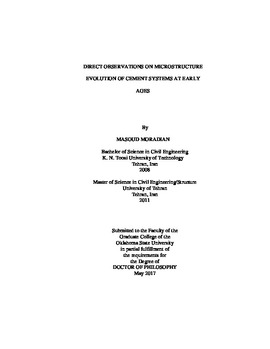| dc.contributor.advisor | Ley, Tyler | |
| dc.contributor.author | Moradian, Masoud | |
| dc.date.accessioned | 2018-03-13T18:16:10Z | |
| dc.date.available | 2018-03-13T18:16:10Z | |
| dc.date.issued | 2017-05 | |
| dc.identifier.uri | https://hdl.handle.net/11244/54578 | |
| dc.description.abstract | There is limited understanding of the mechanisms or direct measurements of cement paste hydration, as the main component that determines mechanical, durability, and rheology properties of concrete. This dissertation uses non-destructive in-situ X-ray imaging at multiple length scales (from 15.6 nm/pixel to 1.45 microm/pixel) to follow the three dimensional microstructural evolution and chemical composition change of ordinary portland cement (OPC) and monoclinic tricalcium silicate (mC3S) paste at early ages. | |
| dc.description.abstract | Microscale resolution observations are made on paste at industrially relevant water-to-solids ratios between 0.40 and 0.70 to investigate the solidification of cement paste, evolution of air-filled void system, and stress induced change in kinetics of hydration. Complementary nanoscale resolution measurements were also made for a collection of OPC and mC3S particles at higher w/s to obtain microstructural and chemical information during hydration. | |
| dc.description.abstract | The results from multiple techniques and different solution environments show that during the first hours of the reaction, hydration products with Ca/Si>3 form on and near the surface of the hydrating particles. These hydration products seem to change in chemistry and density over time. This process seems to be important to the induction and acceleration period of cement hydration. | |
| dc.description.abstract | On the other hand, at the end of the induction period, the volume of air-filled voids reaches a maximum value and then decreases during the acceleration period and stays constant. The void distribution changes from a few coarse voids to a large number of smaller and more uniformly distributed voids after 10 h. This behavior is suggested to be controlled by changes in the ionic strength that cause exsolution of dissolved air from the pore solution. | |
| dc.description.abstract | The results obtained from the loading experiments show that stress applied between 24 h and 60 h alters hydration kinetics of portland cement. The application of load caused an increase in stiffness, early age creep, and dissolution of individual cement particles in the highly loaded samples. These measurements provide insights into the microstructural changes that occur due to early age stress applications during the hydration of portland cement. Mechanisms are presented that discuss the observed behaviors. | |
| dc.format | application/pdf | |
| dc.language | en_US | |
| dc.rights | Copyright is held by the author who has granted the Oklahoma State University Library the non-exclusive right to share this material in its institutional repository. Contact Digital Library Services at lib-dls@okstate.edu or 405-744-9161 for the permission policy on the use, reproduction or distribution of this material. | |
| dc.title | Direct observations on microstructure evolution of cement systems at early ages | |
| dc.contributor.committeeMember | Cross, Stephen A. | |
| dc.contributor.committeeMember | Hartell, Julie Ann | |
| dc.contributor.committeeMember | Apblett, Allen | |
| osu.filename | Moradian_okstate_0664D_15043.pdf | |
| osu.accesstype | Open Access | |
| dc.type.genre | Dissertation | |
| dc.type.material | Text | |
| thesis.degree.discipline | Civil Engineering | |
| thesis.degree.grantor | Oklahoma State University | |
